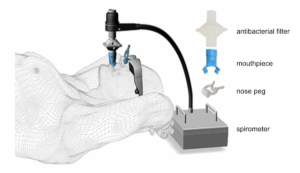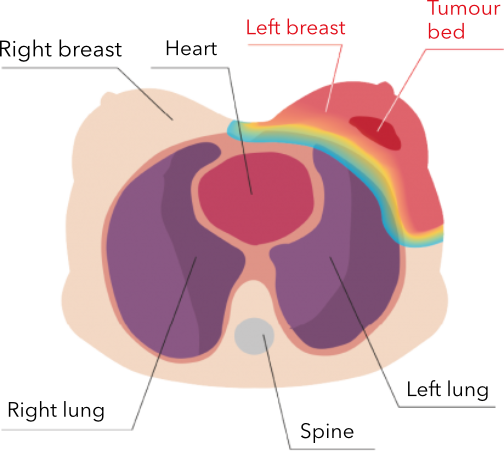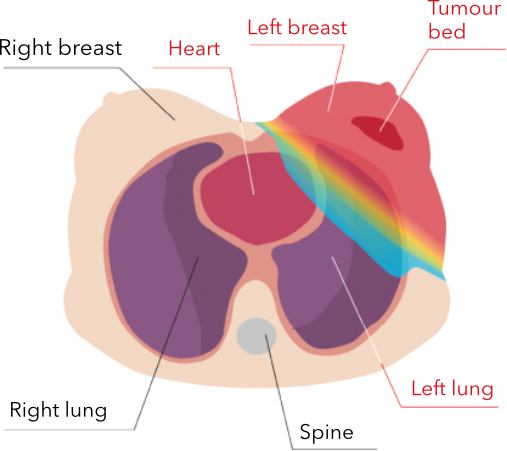
The Prague Proton Therapy Center was the first in the world to develop unique and innovative processes, combining proton radiation, deep inspiration breath hold (DIBH), and body surface detection by the Vision RT system. These procedures minimise undesirable exposure of the heart, coronary arteries, the lungs, and the contralateral breast to radiation. Thanks to this, the Proton Therapy Center is a global leader in the treatment of breast cancer.
Proton therapy is especially beneficial for:
-
tumours located in the left breast,
-
patients who have already undergone a round of radiation for the other breast,
- bilateral findings,
-
patients with associated heart disease.
DIBH: The Controlled Breathing Method
As respiratory movements may impair the correct and precise execution of proton irradiation, in the treatment of breast cancer we also use the method of controlled breathing. For this, we use the Dyn’R.
The controlled breathing method has been chosen because it is important that the irradiated area of the body and the target volume of the tumor are irradiated the same way during each fraction. Since this irradiated volume varies depending on breathing, we need to ensure that the patient’s body is always in the same position. This is best done by holding their breath at a certain level. To determine this level, the patient first undergoes a controlled breathing training (Dyn’R training).
The controlled breathing training is done lying down on the back after being connected to the spirometer, using an antibacterial filter and a mouthpiece. The patient’s nose is held closed by a pin so that all exhaled air flows through their mouth. The patient also wears special glasses, where they see the breathing pattern to follow. The training is conducted by an experienced assistant and the patient has nothing to worry about.
During each irradiation, the patient lies on the radiation table the same way they did during the training, and breathes with the DIBH technique. If the patient accidentally does not manage to hold their breath for the required 20 seconds, they do not have to worry. If they breathe out, the device will detect it and stop irradiation automatically.
Advantages of proton therapy over conventional radiotherapy
One substantial reason to choose proton radiotherapy for breast cancer would be radiation induced heart disease (RIHD). Heart disease caused by radiation is one of the most serious and best-documented very late effects of radiation. Therefore, in the treatment of breast cancer when radiation is recommended, experts seek to minimise the radiation dose to the heart. Thanks to the proton beam, we are able to significantly reduce the risk of the occurrence of cardiac infarction, cardiac complaints, or the risk of development of pulmonary fibrosis.
Very late effects of breast cancer radiation treatment may be manifested in the tissue of the lungs. According to years of experience, irradiation of larger regions of the lungs is unequivocally linked to the development of pulmonary fibrosis, which consists of changes in the pulmonary tissue. Pulmonary fibrosis can be linked to repeated incidences of pneumonia and chronic cough.
Proton therapy is also suitable for patients who have already undergone a round of radiation for the other breast, for bilateral findings, and is also recommended for patients with associated heart disease.
Proton therapy:
- allows for a reduced dose of radiation to the heart by up to 99%;
- allows for a reduced dose to the lungs by up to 81%;
- allows for a reduced dose to the other breast by 96%;
- significantly reduces spinal cord irradiation;
- gives the possibility to choose radiotherapy, even if the disease has relapsed and additional irradiation is needed.
|
PROTON IRRADIATION Protons target the tumour directly, sparing healthy tissues and organs from unwanted effects. |
PHOTON IRRADIATION
|
A team of physicians from MGH in Boston focused on patients with breast cancer. The study concludes that proton radiotherapy of breast cancer especially in patients with necessary radiation of sentinel lymph nodes has a low toxicity while maintaining the same control over cancer as previously published photon radiotherapy data. Proton therapy for breast cancer clearly reduces the risk of side effects.
Proton therapy in Prague
In order to choose the optimal treatment, it is important to receive comprehensive and comprehensible information. If radiation is considered as part of your treatment, ask the treating oncologist about all the available irradiation methods as well as treatment-related side effects. These may significantly affect the quality of your life during and after treatment. Our physicians have many years of experience in radiotherapy. Moreover, they are experienced in both standard (photon) and proton radiation therapy and are prepared to answer all of your questions. Do not hesitate to contact us.
The treatment is outpatient, and you come to the Proton Therapy Center for radiation and regular check-ups during treatment. One visit takes about 60 minutes while the radiation is a matter of a few minutes. Prior to each radiation session, we carefully check your position using X-ray scans and carry out certain other checks necessary to commence irradiating. At least once a week, you undergo check-ups with the physician who will go through the treatment progress with you and check your condition.
In most cases, the whole treatment lasts from 16 to 33 business days, according to the regime determined by the physician on the basis of the initial assessment and other diagnostic tests.


 Photons irradiate the tumour as well as the healthy tissues and organs around it.
Photons irradiate the tumour as well as the healthy tissues and organs around it.